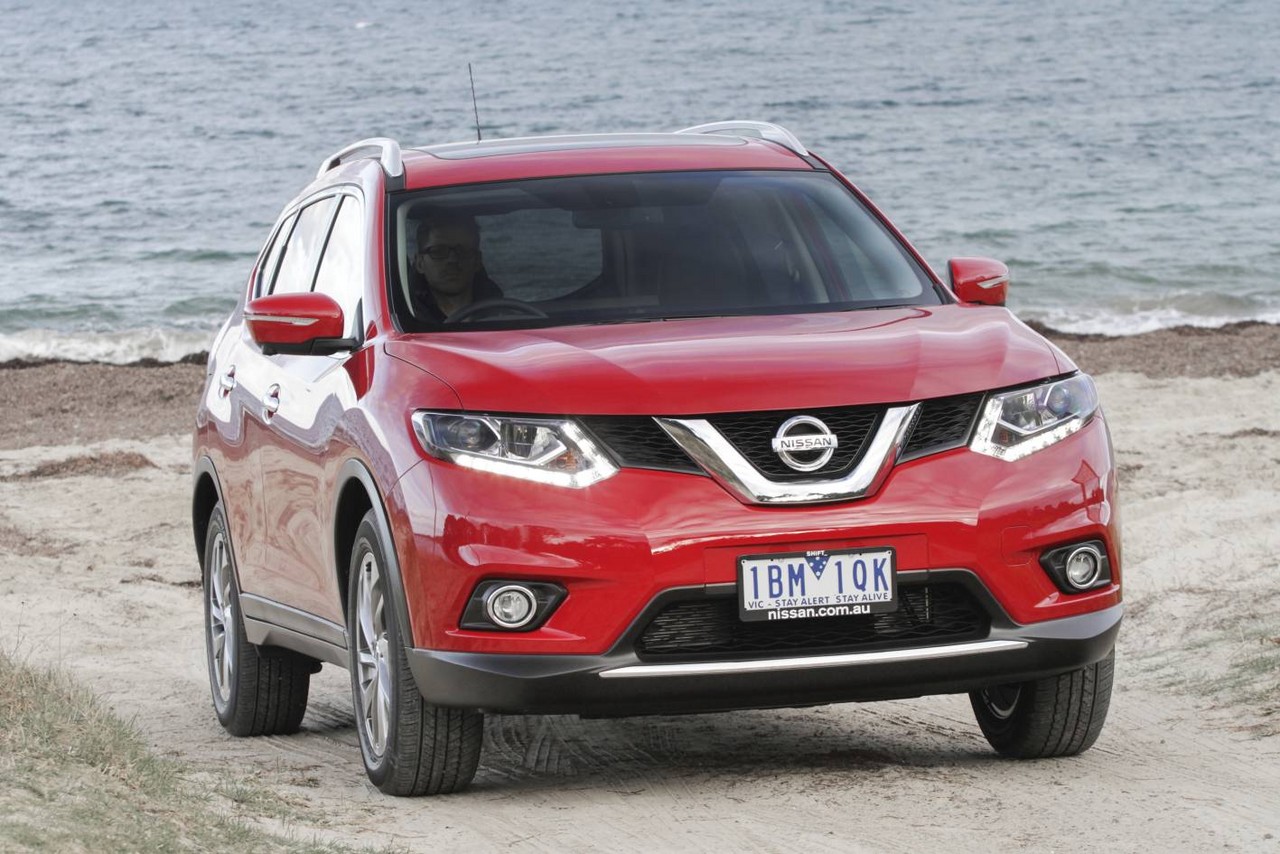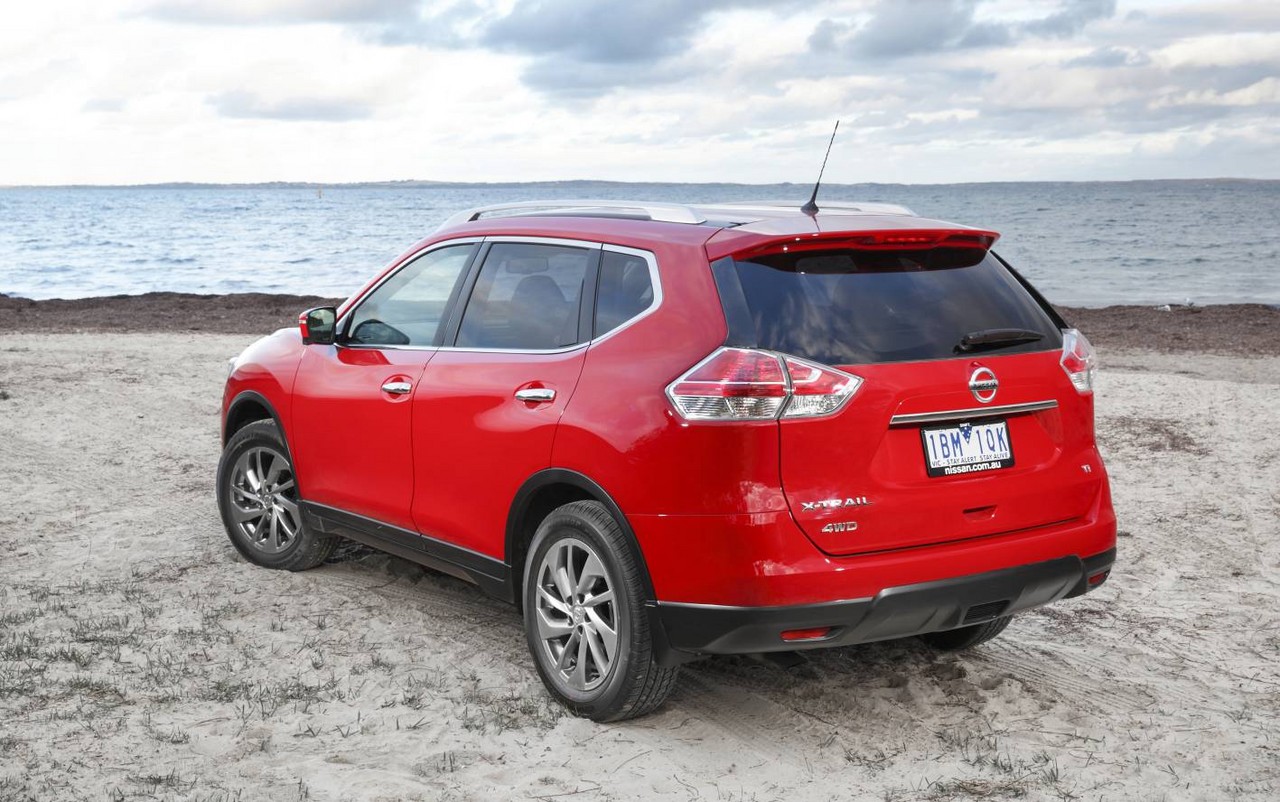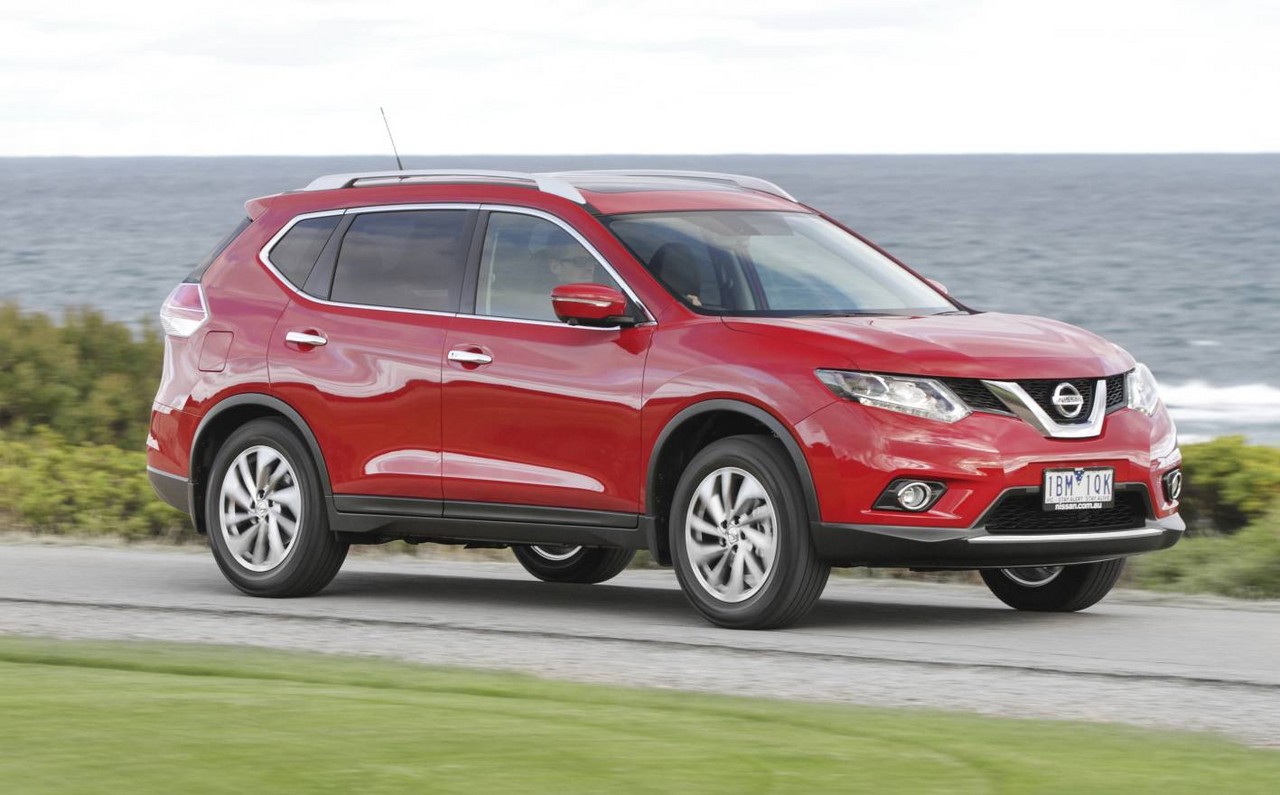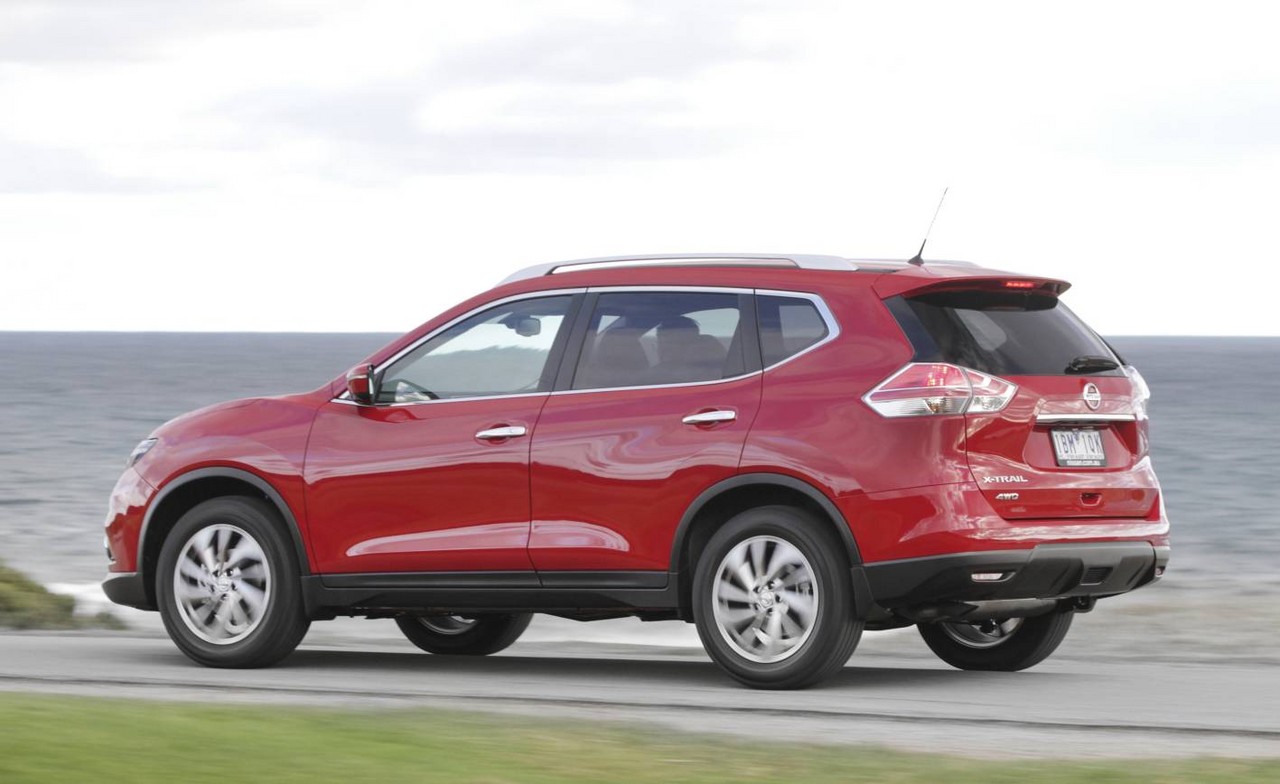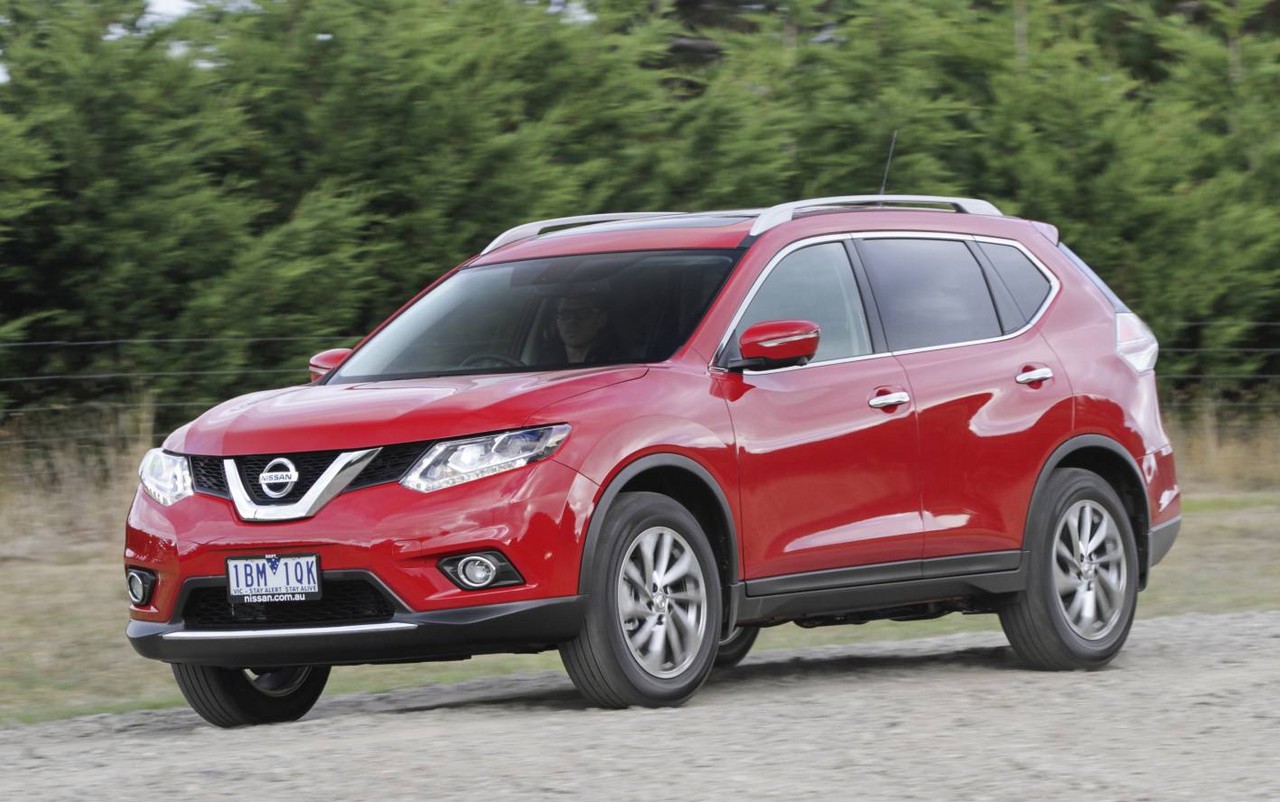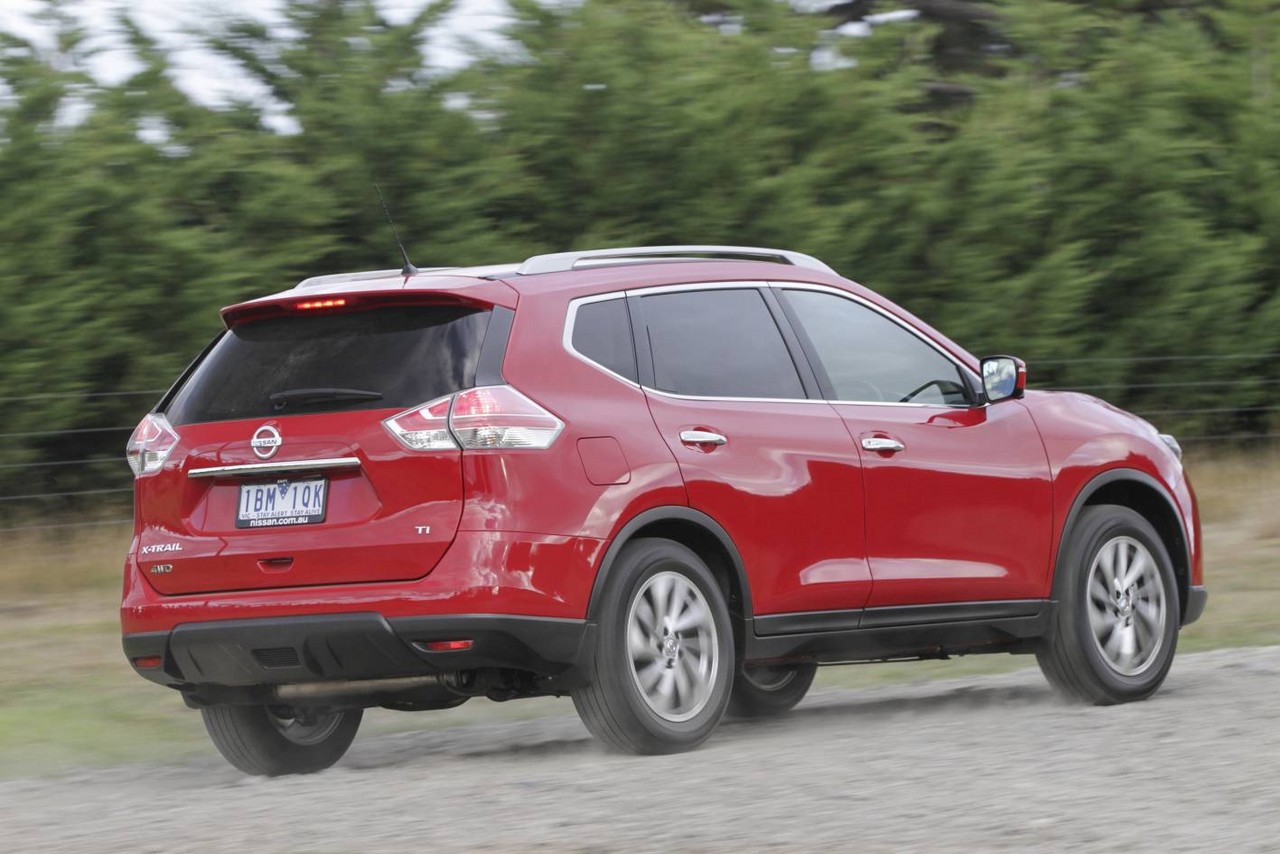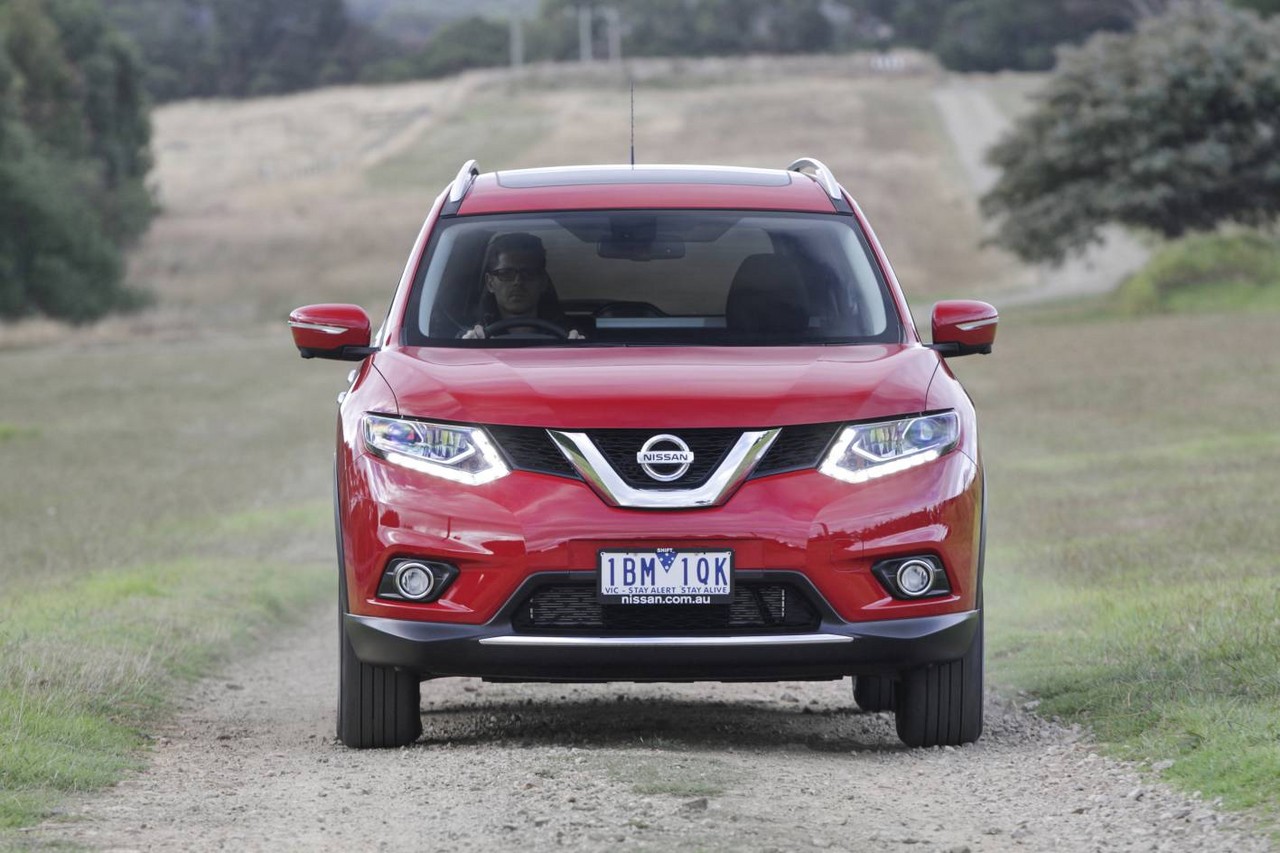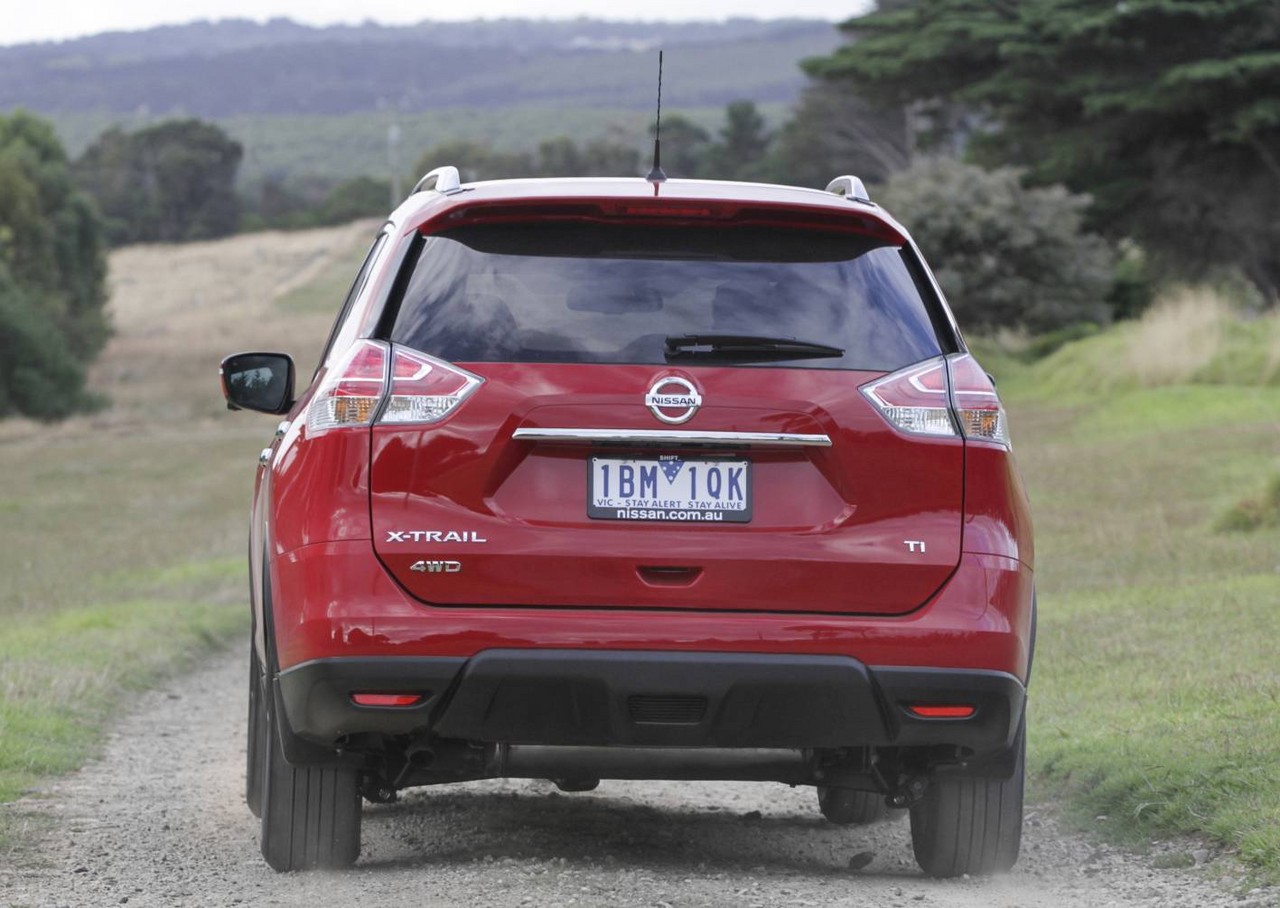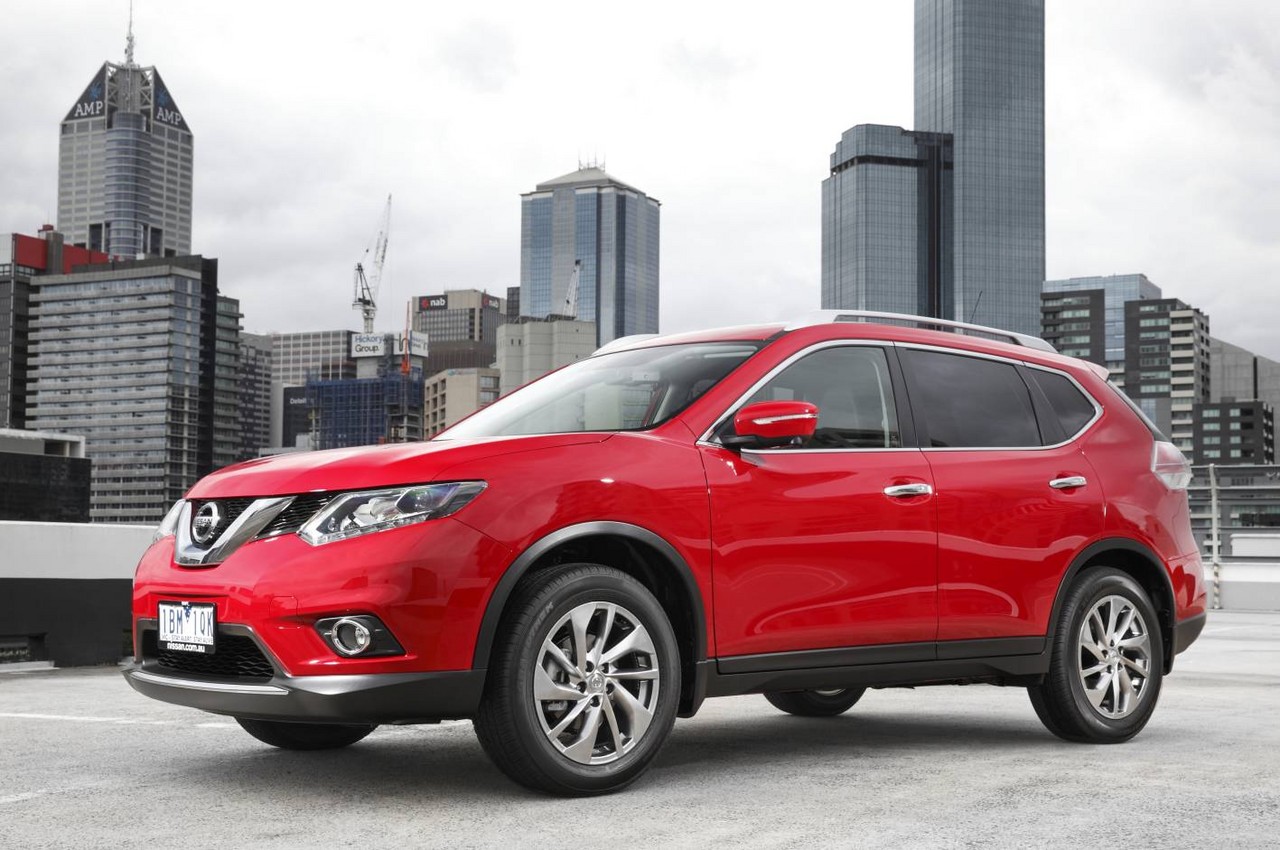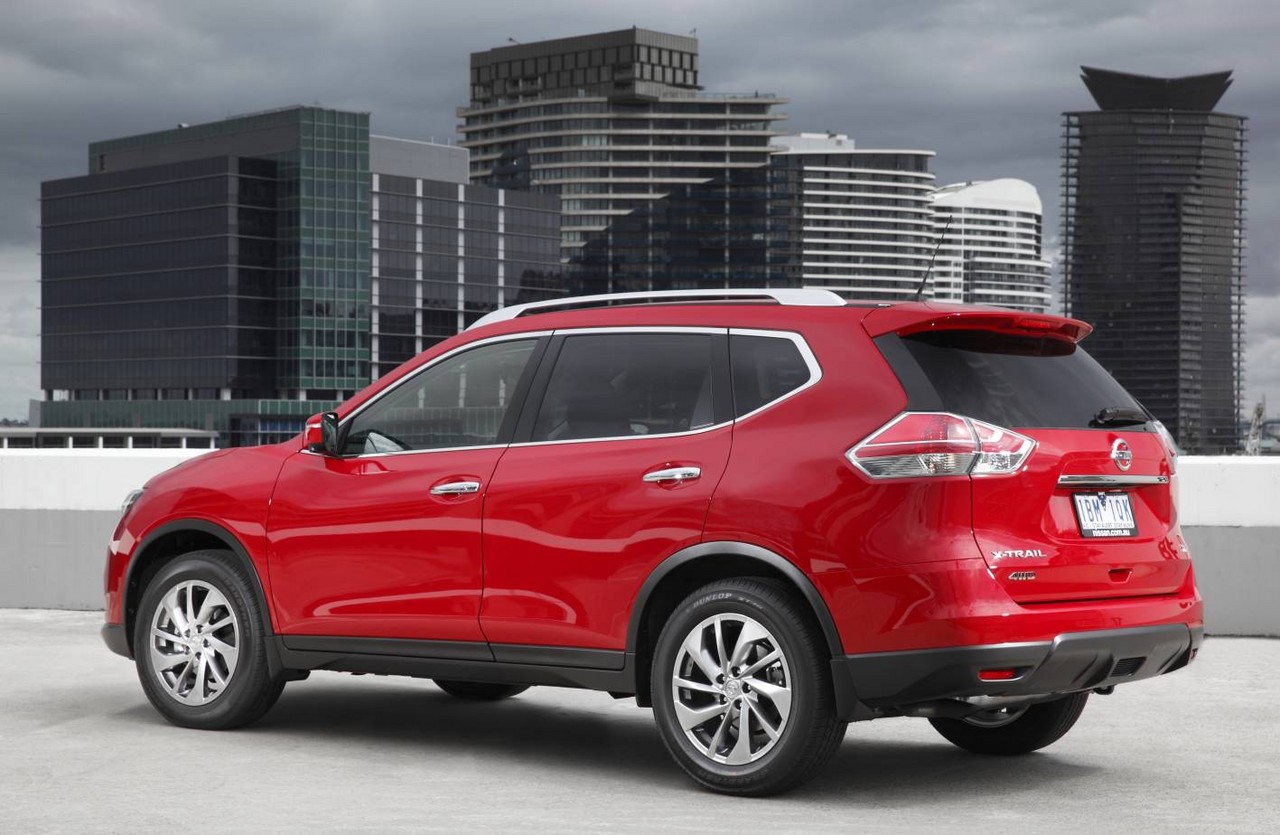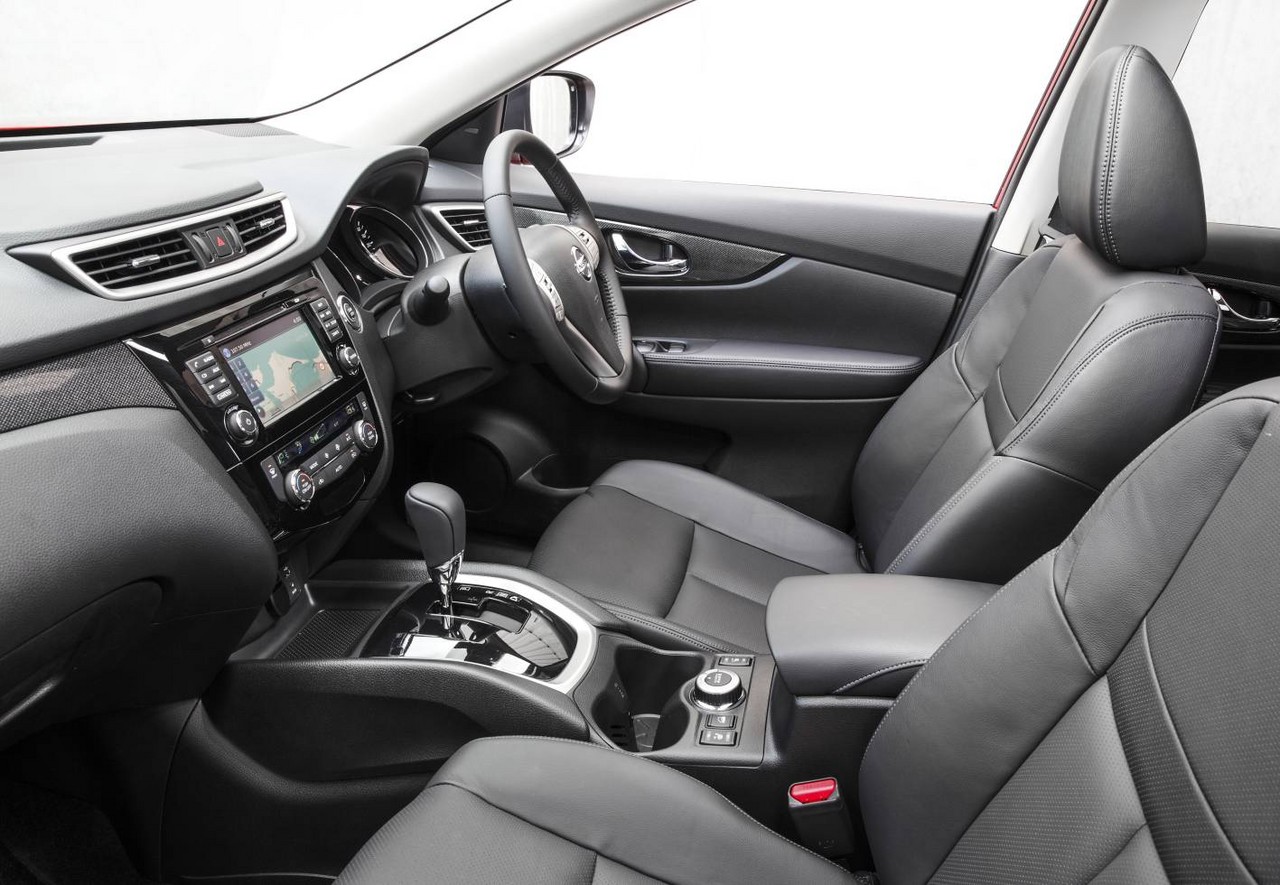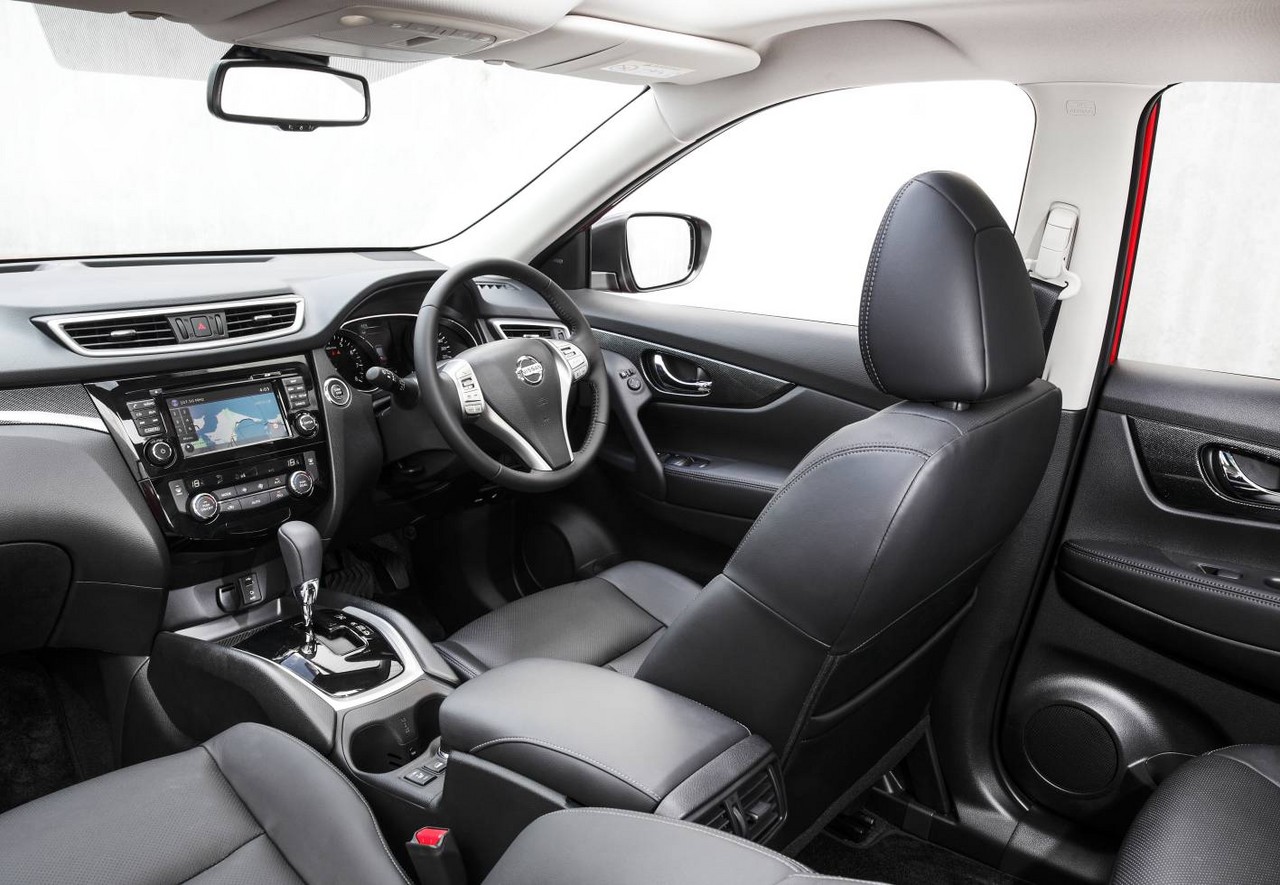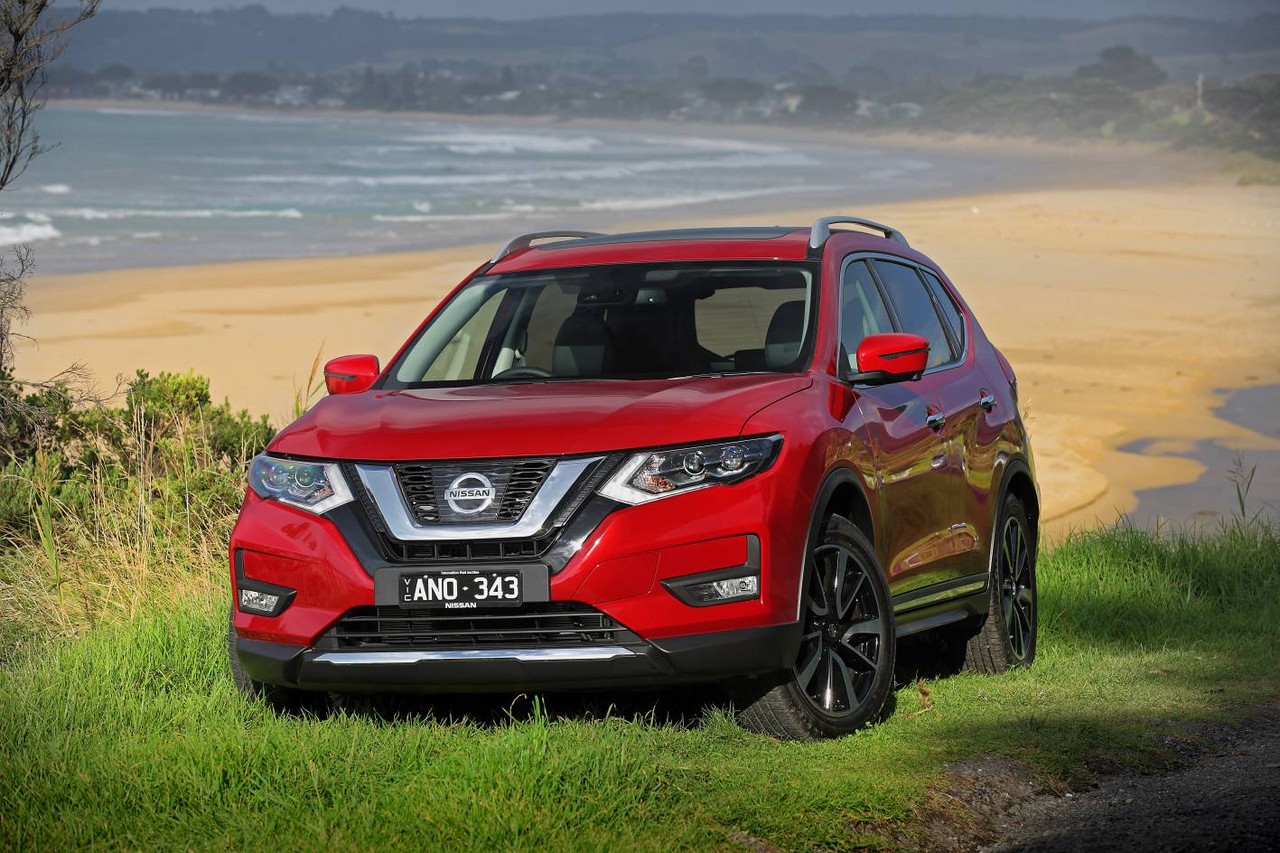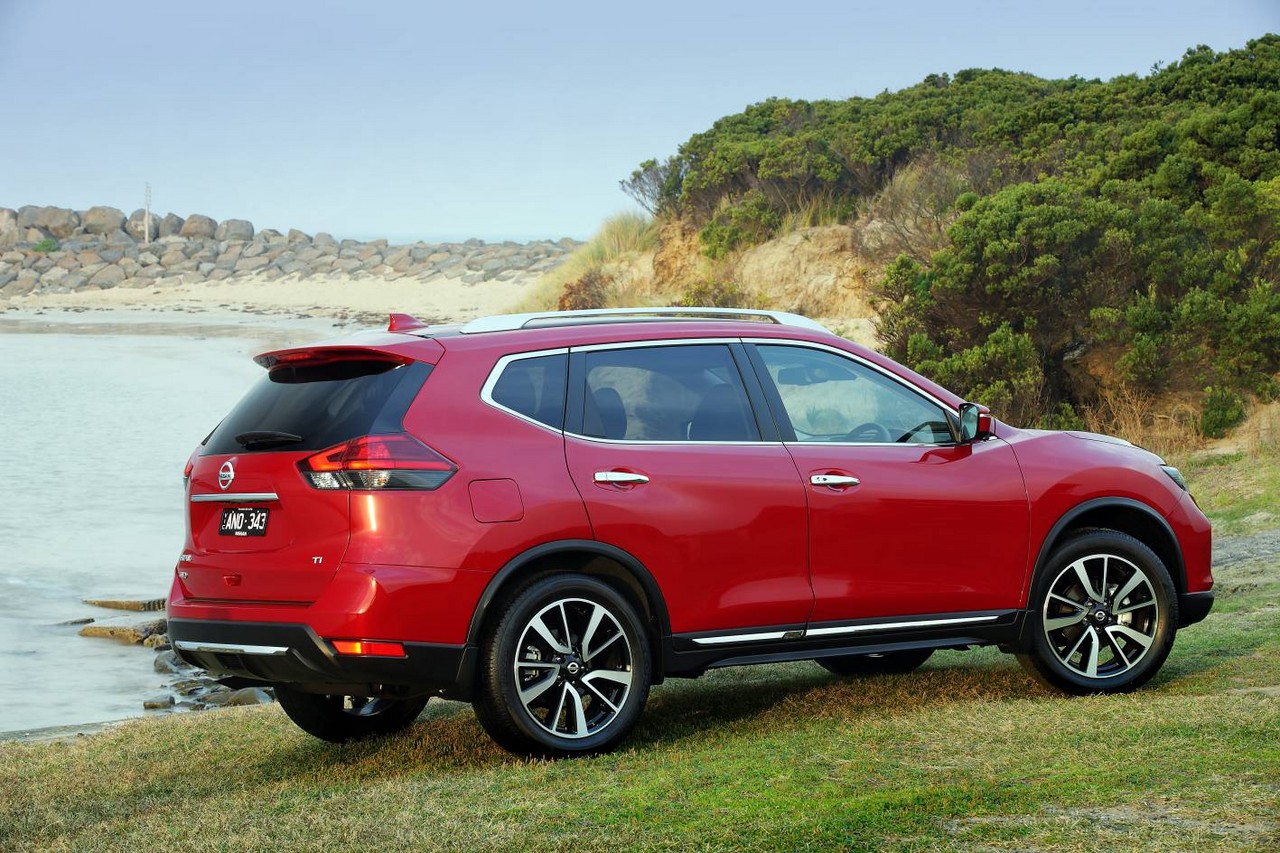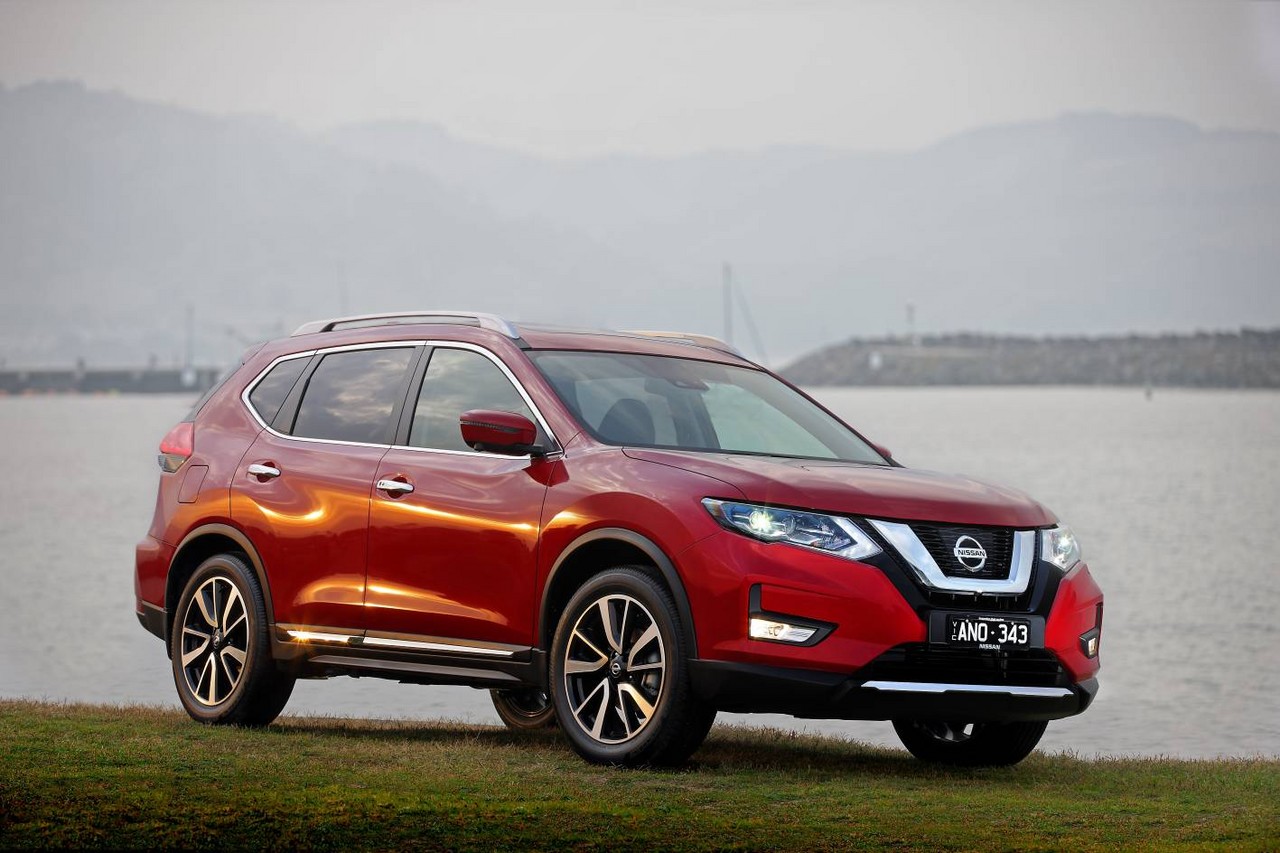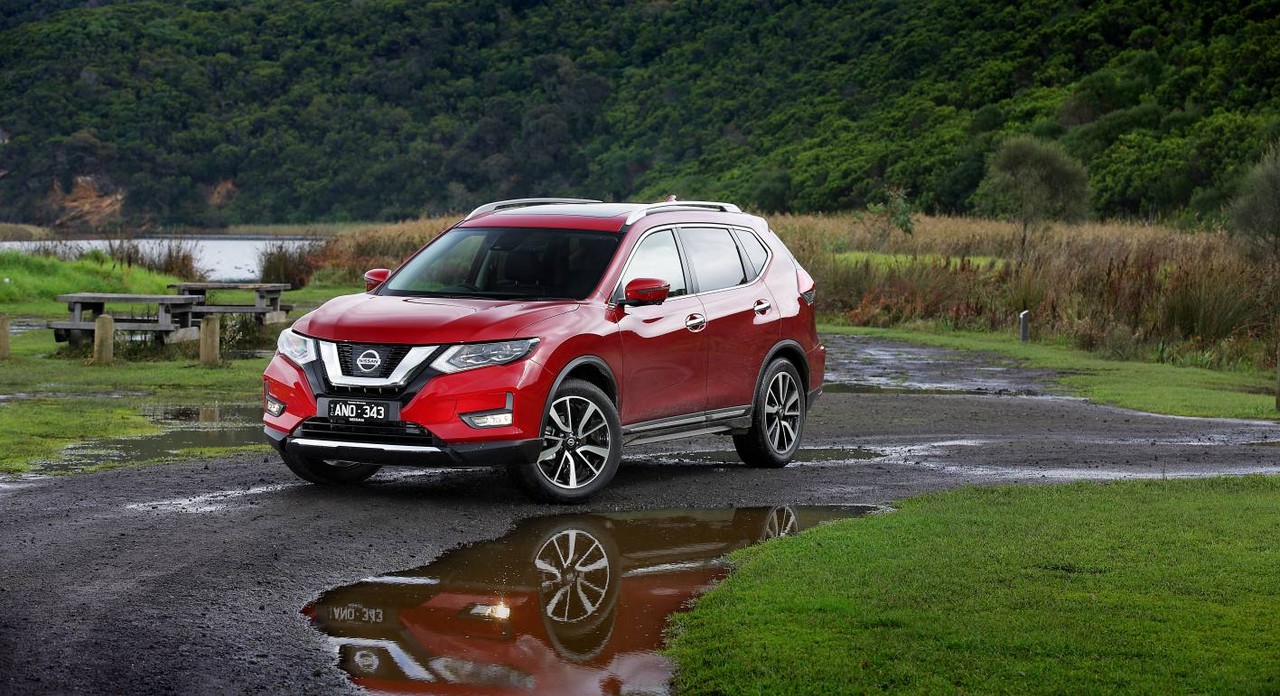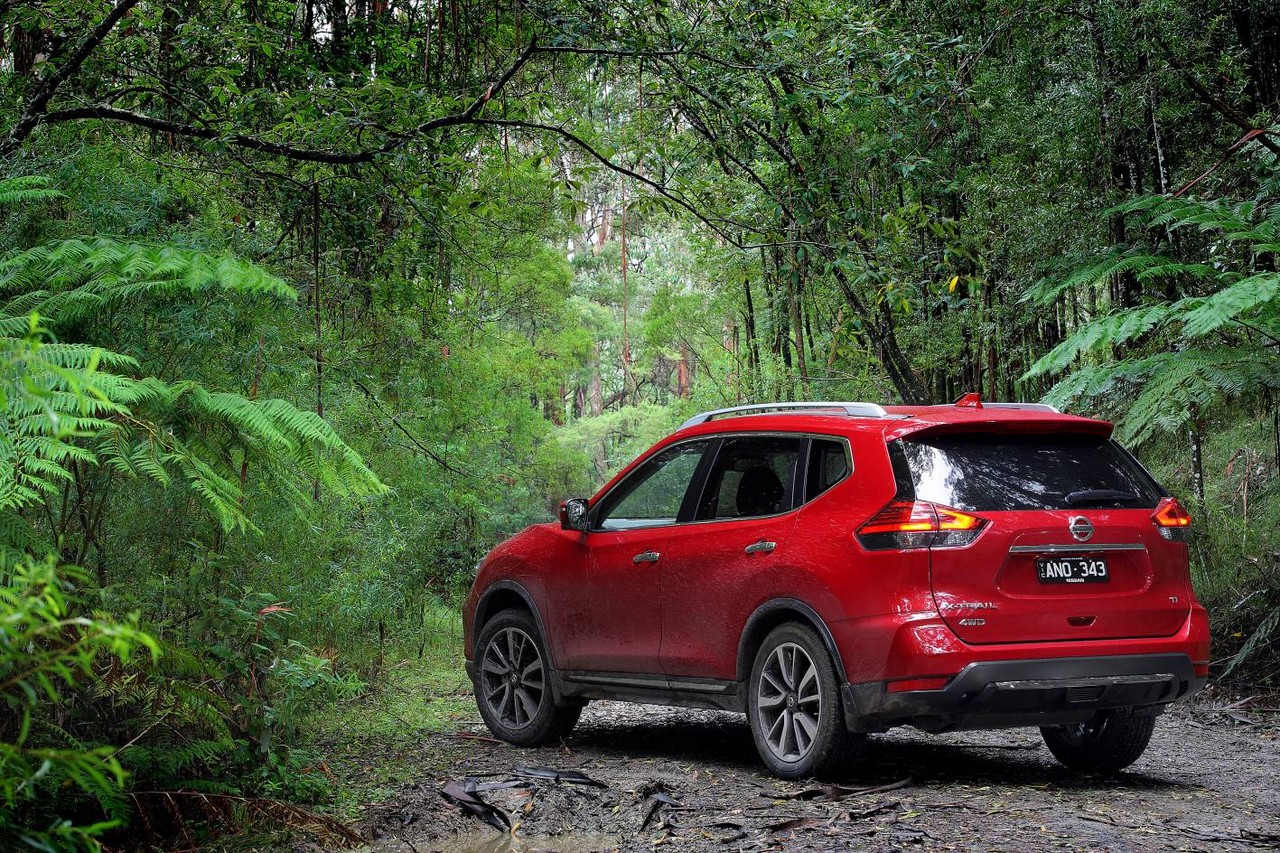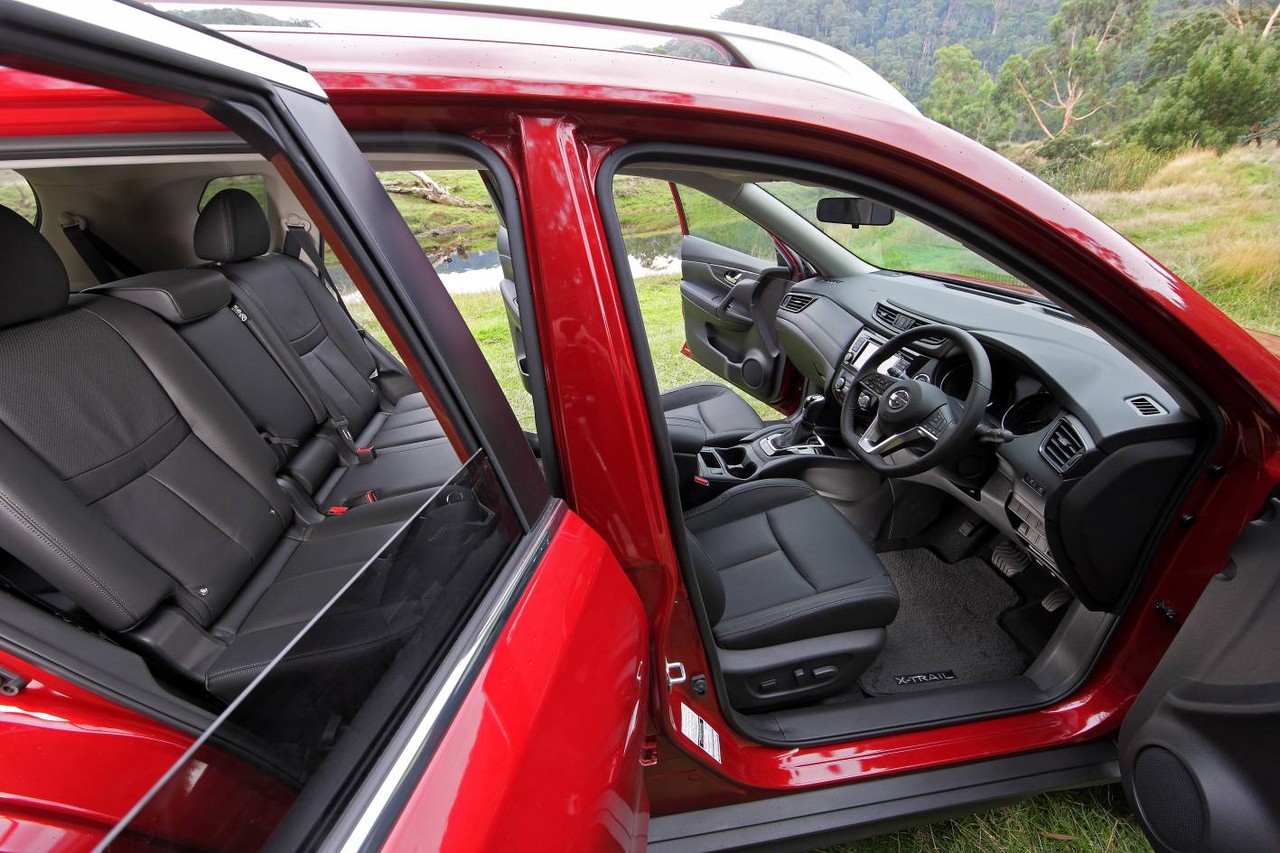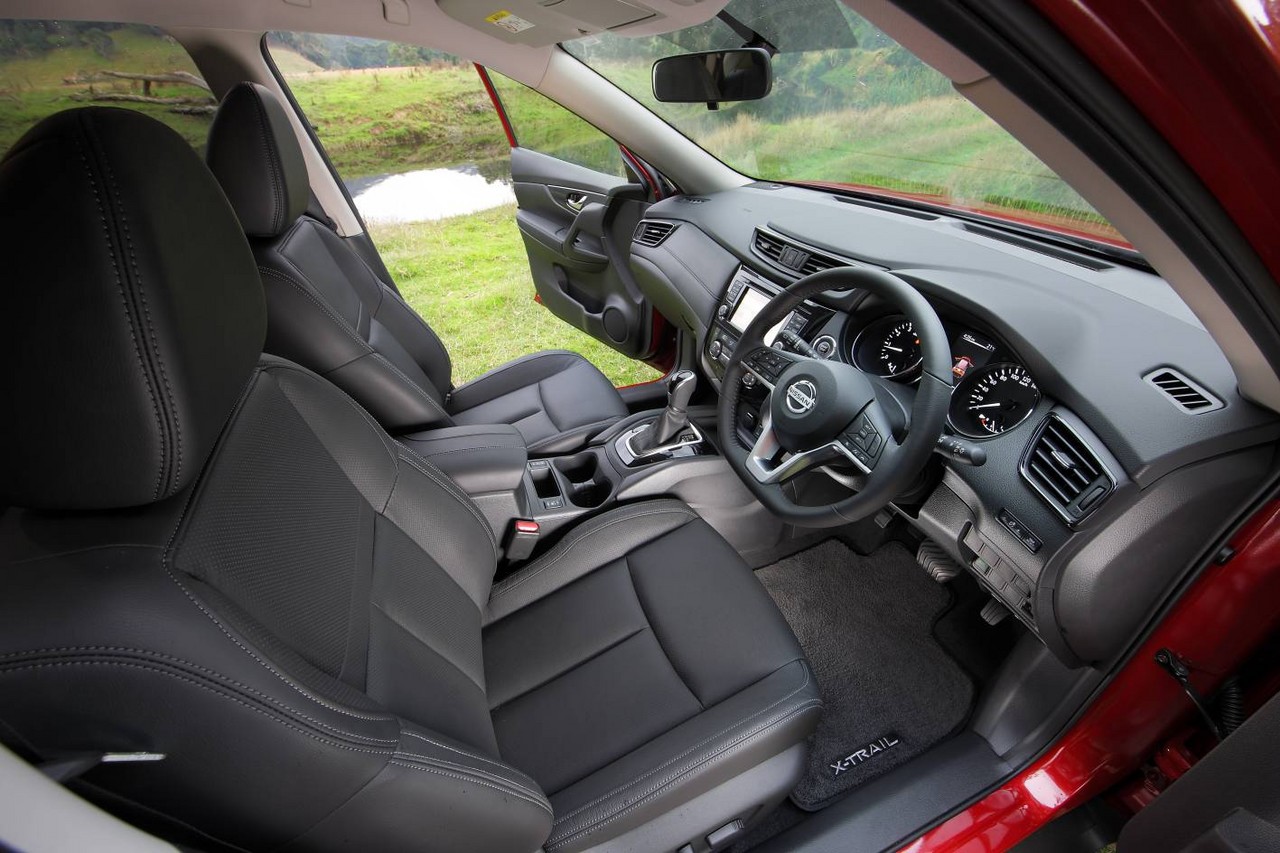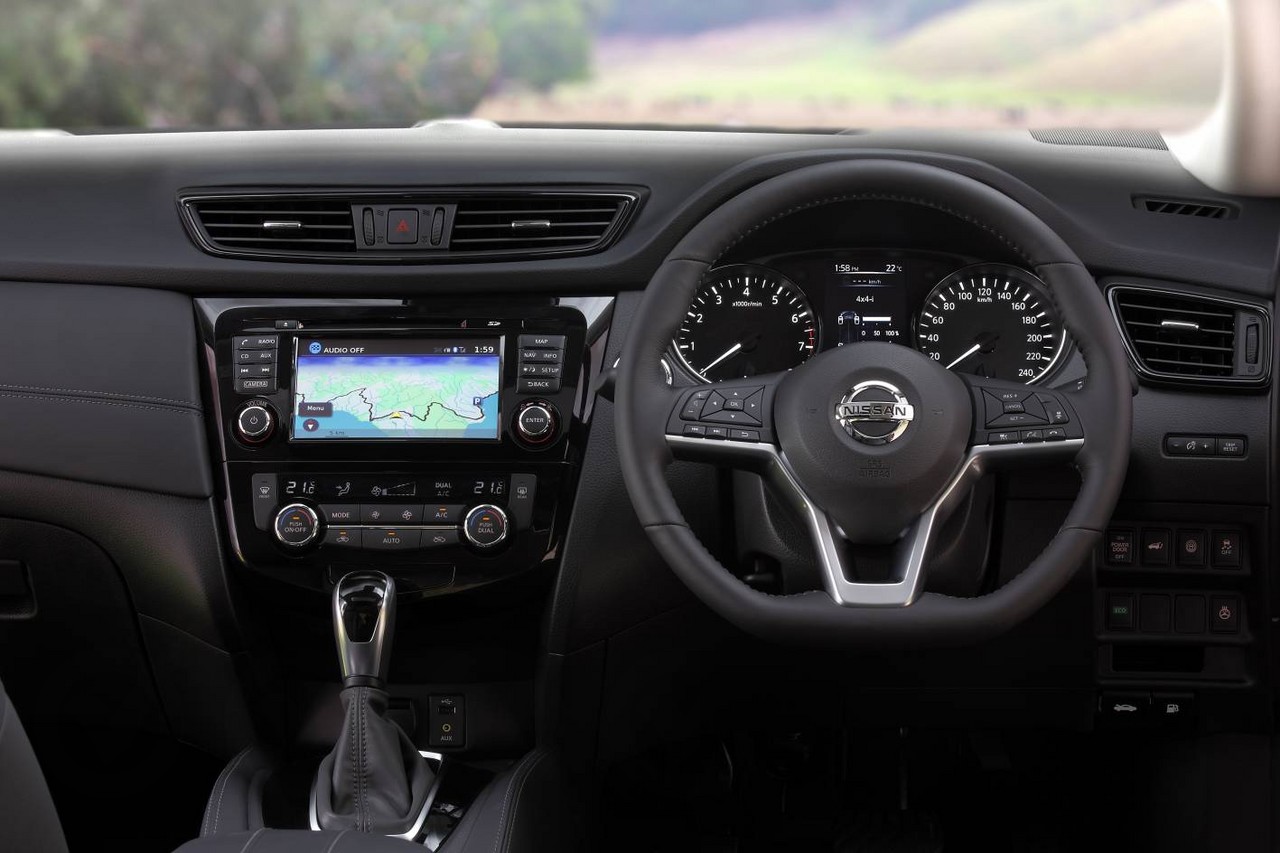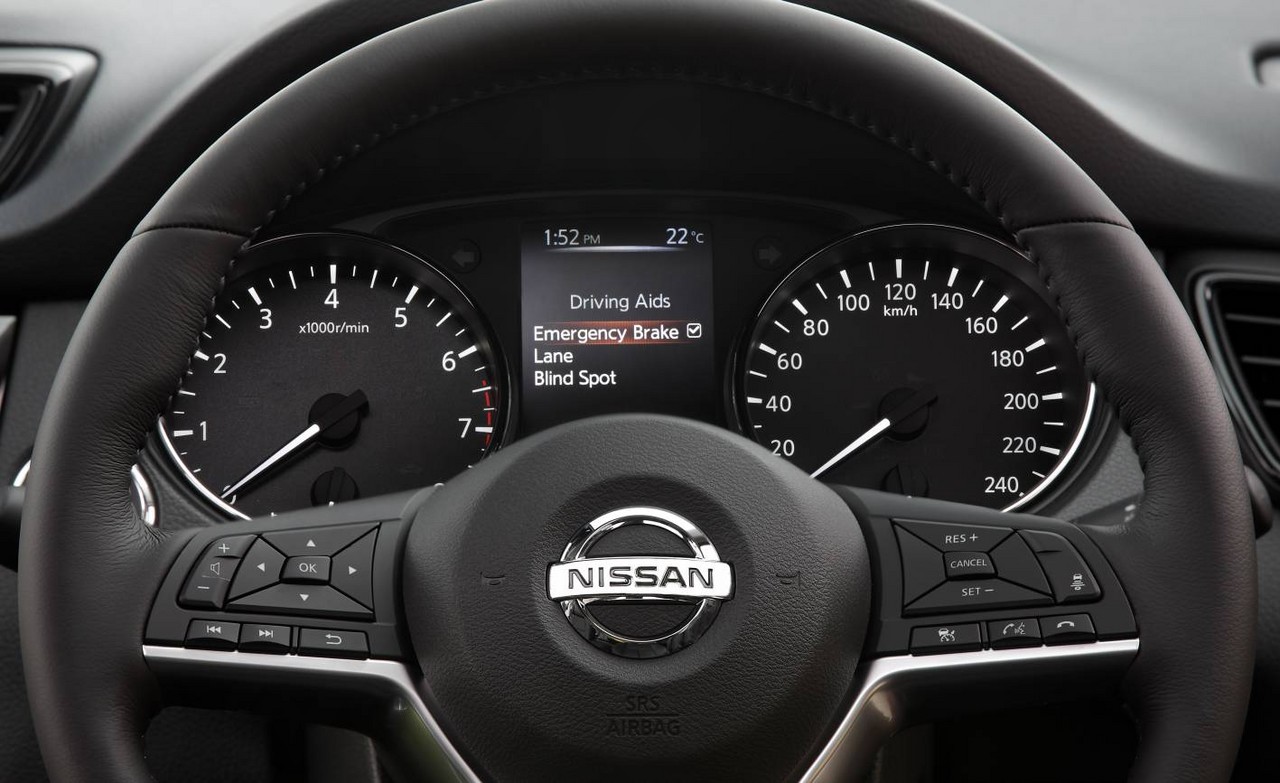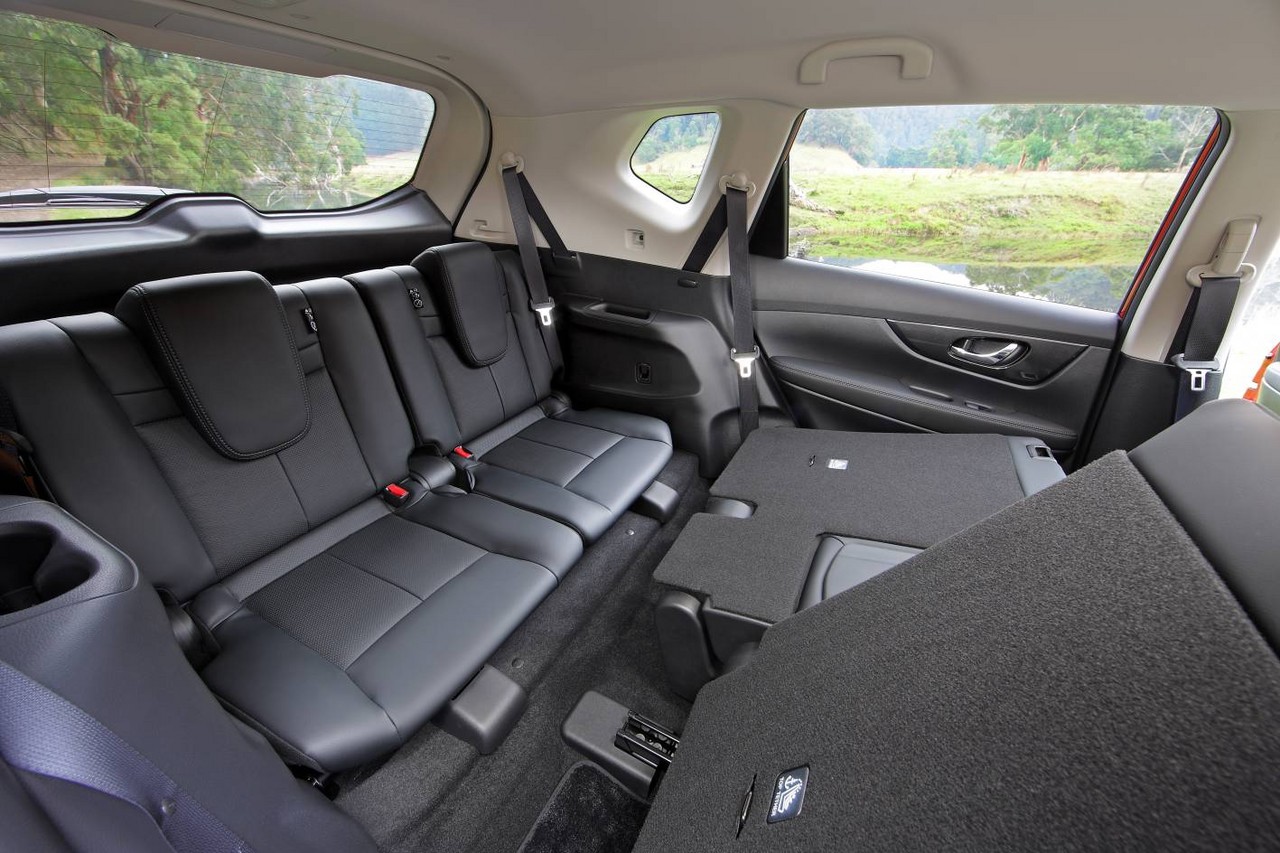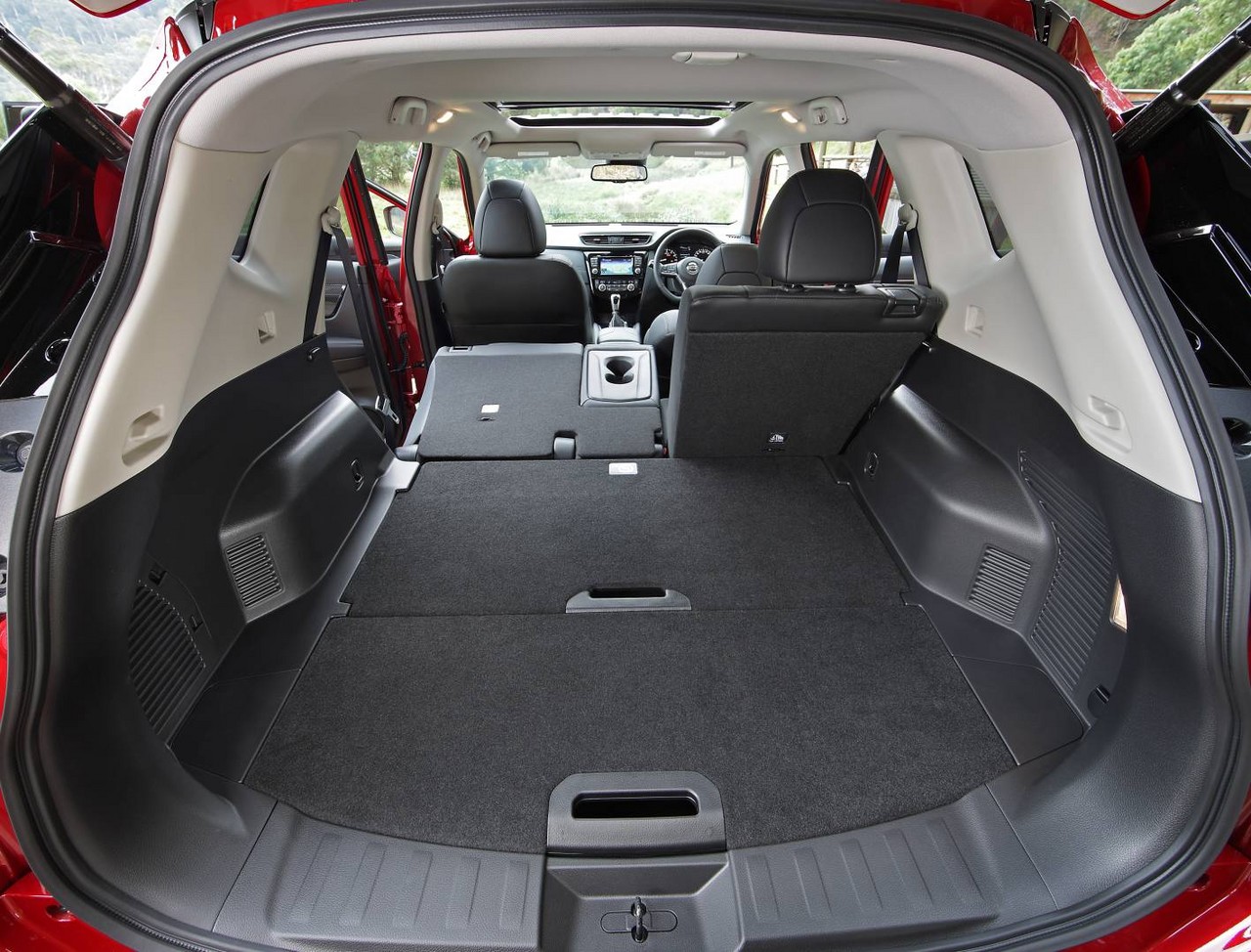
- Refined 2.5-litre petrol engine
- Accomplished ride/handling balance
- Comfortable and supportive front seats
- Spacious interior…
- … though third row seats (where fitted) are only suitable for small children
- Minor turbo lag from 1.6-litre diesel engine
- Overly-assisted steering
- Road noise
- Reports of CVT failure
Review: Nissan T32.I X-Trail (2014-17)
Overview
Released in Australia in March 2014, the Nissan T32 Series I (T32.I) X-Trail was a mid-size SUV. Manufactured in Kyushu, Japan, the T32 X-Trail was initially available with 2.0- and 2.5-litre four-cylinder petrol engines; while the front-wheel drive models with 2.0-litre petrol engines were solely available with five seats, models with 2.5-litre engines were also available with seven seats and all-wheel drive. In October 2014, the range was expanded with 1.6-litre turbo-diesel engines for the TS and TL variants.
MR20DE, QR25DE and R9M engines
Of the engines,
- The 2.0-litre MR20DE four-cylinder petrol engine had an aluminium block and cylinder head, direct fuel injection, double overhead camshafts (chain-driven), four valves per cylinder, variable intake and exhaust valve timing, and a compression ratio of 11.2:1;
- The 2.5-litre four-cylinder QR25DE engine had similar properties but differed in that it had multi-point fuel injection and a compression ratio of 10.0:1. Models with 2.5-litre petrol engines were also fitted with Active Engine Brake which used the continuously variable ‘Xtronic’ transmission to provide engine braking while cornering or coasting to a stop. According to Nissan, the Active Engine Brake function provided greater braking control and enhanced feel with less pedal effort; and,
- Manufactured by Renault at its Cleon plant, the 1.6-litre R9M turbo-diesel engine had common-rail injection, double overhead camshafts (chain-driven), four valves per cylinder and a compression ratio of 15.4:1. New features for the R9M engine included a variable displacement oil pump, variable swirl technology, a multi-injection system to optimize particulate filter regeneration and low-pressure exhaust gas recirculation. The engine also had an Idle Stop/Start system which enabled it to shut down when the vehicle was stationary in traffic to conserve fuel.
| Engine | Drive | Variant | Seats | Trans. | Peak power | Peak torque |
|---|---|---|---|---|---|---|
| 2.0-litre petrol I4 (MR20DE) |
FWD | ST | 5 | 6sp man. | 106 kW at 6000 rpm | 200 Nm at 4400 rpm |
| 2.5-litre petrol I4 (QR25DE) |
FWD | ST, ST-L |
5 or 7 | CVT | 126 kW at 6000 rpm | 226 Nm at 4400 rpm |
| AWD | ST, ST-L, Ti |
5 | CVT | 126 kW at 6000 rpm | 226 Nm at 4400 rpm | |
| 1.6-litre turbo-diesel I4 (R9M) |
FWD | TS, TL |
5 | CVT | 96 kW at 4000 rpm | 320 Nm at 1750 rpm |
| AWD | TS, TL |
5 | 6sp man. | 96 kW at 4000 rpm | 320 Nm at 1750 rpm |
Transmissions
Transmission options initially consisted of six-speed manual and CVT units. All models within the X-Trail range, however, were fitted with Hill Start Assist which would automatically apply the vehicle’s brakes when the vehicle was about to accelerate from rest and the vehicle was on an incline.
Dimensions
Compared to the Nissan T31 X-Trail , the T32 X-Trail was 5 mm longer (at 4640 mm), 30 mm wider (1820 mm), 10 mm taller (1710 mm) and had a 75 mm longer wheelbase (2705 mm). Inside, five-seat models had 40/20/40 split and folding second row seats and ‘Divide-N-Hide’ storage system which consisted of luggage boards that enabled the cargo area to be separated into upper and lower areas. Seven seat models, however, omitted the Divid-N-Hide storage system and had 50/50 split and folding third row seats.
Suspension and steering
The Nissan T32 X-Trail had MacPherson strut front suspension and independent, multi-link rear suspension. As standard, the T32 X-Trail was also fitted with an ‘Active Ride Control’ system which monitored the road surface to detect undulations which could upset the pitch of the car body and alters suspension damping to compensate.
The Nissan X-Trail had rack-and-pinion steering with electric power assistance.
All Mode 4x4i
The T32 X-Trail was available with Nissan’s ‘All Mode 4×4-i’ system which utilised an electronically-controlled coupling and enabled the driver to use a rotary switch on the centre console to select from the following drive modes:
- 2WD: front-wheel drive only in normal conditions. If a loss of traction was detected, however, all-wheel drive would be engaged for additional traction;
- Auto (default): at speeds of up to 80 km/h, Auto mode was predominantly front-wheel drive but had a predictive function – based on throttle position and engine speed – which could anticipate wheel spin and redirect torque accordingly. Beyond 80 km/h, however, the system reacted to wheel-spin by shifting drive rearwards to restore traction as required; and,
- Lock: for difficult conditions and at speeds less than 40 km/h, ‘Lock’ provided permanent four-wheel drive with a fixed 50:50 front:rear torque distribution.
Models with the All Mode 4x4i system were also fitted with a ‘Hill Descent Control’ function which used the X-Trail’s ABS system to control the vehicle speed at approximately 7 km/h when traversing steep downhill terrain.
Safety equipment
Standard safety equipment for the Nissan T32 X-Trail included dual front airbags, front side airbags, curtain airbags (i.e. for front and second row occupants), ABS, electronic brake force distribution, brake assist, electronic stability control, traction control and front seatbelts with pretensioners and load limiters.
The X-Trail Ti and TL variants were further equipped with:
- Lane Departure Warning (LDW): operated at speeds above 70 km/h and used the rear camera to detect lane markings and warn the driver if they drifted from their lane without indicating;
- Blind Spot Warning (BSW): operated at speeds above 32 km/h and could detect vehicles in the driver’s left and right blind spots. In addition to an audible tone, BSW would give the driver a visual warning via lights that illuminated in the corresponding rear-view mirror housing; and,
- Moving Object Detection (MOD): operated at speeds below 8 km/h and used the rear camera to detect any moving objects at the rear of the vehicle when reversing. If a moving object was detected, the driver would be alerted by an on-screen image in the seven-inch display and an audible tone.
Euro NCAP testing
In Euro NCAP testing , the 2014 Nissan X-Trail received a five star safety rating which included an 86 per cent adult occupant protection rating and an 83 per child occupant protection rating. In the offset crash test, protection of the driver’s head, thighs and feet were rated as good, while chest and lower leg protection were rated as adequate. Maximum points were awarded in the side impact test though, in the more severe pole test, chest protection was rated as adequate.
Under ANCAP’s methodology , this testing resulted in a five star adult occupant protection rating with a score of 35.28 out of 37.
Features: X-Trail ST, TS, ST-L, Ti and TL
Standard features for the X-Trail ST and TS included 17-inch alloy wheels with 225/65 R17 tyres, a six speaker sound system with a CD player, MP3-compatibility and auxiliary inputs (3.5 mm/USB/iPod), NissanConnect with Bluetooth mobile phone connectivity, audio streaming and a five-inch LCD colour monitor, air conditioning, cruise control, a rear view camera, daytime LED running lights, automatic headlights, 40/20/40 split and folding second row seats, steering wheel audio controls, remote central locking with proximity key (‘Nissan Intelligent key’), power windows and mirrors, tilt and telescopic steering column adjustment, push button start, three 12 volt power outlets, a cargo blind, trip computer and an immobiliser.
Beyond this, the X-Trail ST-L added satellite navigation with a seven-inch LCD colour monitor, digital radio (DAB), dual-zone climate control air conditioning, leather seat trim, power adjustable and heated front seats, an Around View Monitor, front fog lights, a leather-wrapped steering wheel and gearshift knob, heated door mirrors, roof rails and privacy glass.
The range-topping X-Trail Ti and TL were distinguished by their 18-inch alloy wheels with 225/60 R18 tyres, LED headlights, rain-sensing wipers, power tilt and slide sunroof, and an electrochromatic rear view mirror. For Ti variants, the driver could also open the tailgate via the key fob or by moving their foot in the area under the X-Trail’s rear bumper to activate the motion-sensors.
2016 Nissan X-Trail N-Sport Special Edition Black and Special Edition Silver
The Nissan X-Trail N-Sport Special Edition Black and Special Edition Silver were released in July 2016. Based on either the X-Trail ST or ST-L variants, the X-Trail N-Sport Special Edition Black was distinguished by its gun metallic finishes for the 17-inch alloy wheels, front grille, front bumper finisher, fog lamp finisher (ST-L based models only), side skirts and rear bumper finisher.
The X-Trail N-Sport Special Edition Silver, however, was differentiated by its unique 17-inch alloy wheels, silver front bumper finisher, silver fog lamp finisher (ST-L based models only), silver side skirts and silver rear bumper finisher.
Brochure
Specifications
Review: Nissan T32.II X-Trail (2017-22)
Overview
Officially released in Australia in May 2017, the Nissan T32.II X-Trail introduced a new 2.0-litre M9R turbo diesel engine which replaced the 1.6-litre R9M turbo diesel engine that was offered in the T32.I X-Trail range.
The T32.II X-Trail had five seats as standard and these models had a ‘Divide-N-Hide Cargo System’ which provided adjustable space variations within the cargo area. However, front-wheel drive ST and ST-L variants which had 2.5-litre petrol engines could be specified with seven seats; these models had an ‘EZ Flex Seating System’ which enabled the third row seats to slid forward, backwards or fold down.
Visually, the Nissan T32.II X-Trail could be identified by its New front fascia with integrated fog lamps, bumper, ‘V-motion’ grille and revised headlights with LED daytime running lights. At the rear, there was a new bumper and revised combination lamps with LED boomerang signature lights. The X-Trail Ti and TL variants were also fitted with new chrome side door mouldings and 19-inch alloy wheels.
Inside, the Nissan T32.II X-Trail had a new D-shaped steering wheel, a new gear-shift knob and leather gear-shift boot, new door and instrument panel finishers, and a revised centre console and lid. Furthermore, the T32.II X-Trail had additional damping and sound absorption materials in the floor and body pillars to reduce interior noise.
| Engine | Drive | Variant | Seats | Trans. | Peak power | Peak torque |
|---|---|---|---|---|---|---|
| 2.0-litre petrol I4 (MR20DE) |
FWD | ST | 5 | 6sp man. | 106 kW at 6000 rpm | 200 Nm at 4400 rpm |
| 2.5-litre petrol I4 (QR25DE) |
FWD | ST, ST-L |
5 or 7 | CVT | 126 kW at 6000 rpm | 226 Nm at 4400 rpm |
| AWD | ST, ST-L, Ti |
5 | CVT | 126 kW at 6000 rpm | 226 Nm at 4400 rpm | |
| 2.0-litre turbo-diesel I4 (M9R) |
AWD | TS, TL |
5 | 6sp man. | 130 kW at 3750 rpm | 380 Nm at 2000 rpm |
Safety equipment
For the Nissan T32.II X-Trail, standard safety equipment was extended to include –
- Forward Collision Warning (FCW): used a radar sensor to monitor traffic in front of the X-Trail. If the distance to the vehicle ahead decreased such that there was a risk of collision, an audible warning would be emitted and a visual signal would appear on the instrument panel; and,
- Intelligent Emergency Braking: if the driver did not respond to the Forward Collision Warning System, the brakes would be applied automatically to reduce vehicle speed so that the collision could be avoided or its severity reduced. Intelligent Emergency Braking operated at speeds above 5 km/h.
Beyond this, the T32.II X-Trail ST, Ti and TL were further equipped with Rear Cross Traffic Alert (RCTA). When reversing out of a parking space at speeds below 8 km/h, RCTA could detect approaching vehicles that could cross the X-Trail’s intended path and alert the driver by illuminating LEDs in the corresponding door mirror. As with the T32.I X-Trail, the ST, Ti and TL variants continued to be fitted with Nissan’s Around View Monitor (AVM).
For the Nissan T32.II X-Trail Ti and TL, the Intelligent Emergency Braking system had a pedestrian detection function which operated at speeds from 10 km/h to 60 km/h. As with the T32.I X-Trail, the X-Trail Ti and TL were also fitted with Lane Departure Warning (LDW), Blind Spot Warning (BSW) and Moving Object Detection (MOD).
For the T32.II X-Trail Ti, standard safety equipment was extended to include –
- Intelligent Cruise Control (ICC): when cruise control was active, Intelligent Cruise Control could adjust vehicle speed to maintain a specified distance from the vehicle ahead and accelerate up to the cruising speed once the path was clear; and,
- Lane Departure Intervention (also called Lane Departure Prevention): operating at speeds above 60 km/h, LDI used a camera positioned behind the windscreen to detect lane markers and calculate the vehicle’s relative position. If the system detected that the X-Trail was approaching lane markers as a result of driver inattention, a buzzer would sound and a message would appear in the instrument cluster to alert the driver. Then, the brakes would be applied on one side of the vehicle to generate a yaw moment and direct the vehicle back to the centre of its lane.
Features: Nissan T32.II X-Trail
Compared to the Nissan T32.I X-Trail, standard features for the T32.II X-Trail ST and TS were extended to include daytime running lights, while features for the X-Trail ST-L were unchanged.
For the T32.II X-Trail Ti and TL, however, standard features were extended to include 19 x 7.0J alloy wheels with 225/55 R19 tyres, Bose audio system with eight speakers (including two sub-woofers), heated outer rear seats and a heated steering wheel. These variants also gained the following technologies –
- Adaptive Front Lighting System: could alter light distribution from the headlights to compensate for road curvature and illuminate the chosen direction of travel at intersections;
- High Beam Assist: could detect oncoming traffic and switch from high beams to low beams, and then revert to high beams once the vehicle had passed; and,
- A motion-activated tailgate which used a sensor to detect a kicking motion beneath the rear bumper.
2018 Nissan X-Trail ST-L N-Sport
The Nissan X-Trail ST-L N-Sport was released in August 2018 and available in front- and all-wheel drive models. Visually, the X-Trail ST-L N-Sport could be identified by its 18-inch black alloy wheels, a dark chrome front grille, black side sills, gloss black door mirror caps, dark metallic front and rear bumper finishers, and black roof rails. The Nissan X-Trail ST-L N-Sport was available in four paint finishes: Diamond Black, Gun Metallic, Brilliant Silver and Ivory Pearl. Furthermore, Australian deliveries of the X-Trail ST-L N-Sport were limited to six hundred (600) vehicles.
2019 Nissan X-Trail N-Trek Special Edition
Available in front- and all-wheel drive models, the Nissan X-Trail N-Trek was released in Australia in November 2019. Based on the X-Trail ST-L, the X-Trail N-Trek was further equipped with 19-inch alloy wheels, an eight speaker Bose audio system. Visually, the X-Trail N-Trek could be identified by the following Nissan accessories: a smoked colour bonnet protector and slim line weather shields (front and rear), kick plates (front and rear). Inside, the X-Trail N-Trek also had rear carpet mats.
Australian deliveries of the Nissan X-Trail N-Trek were limited to five hundred (500) vehicles.
Specifications
Related links
